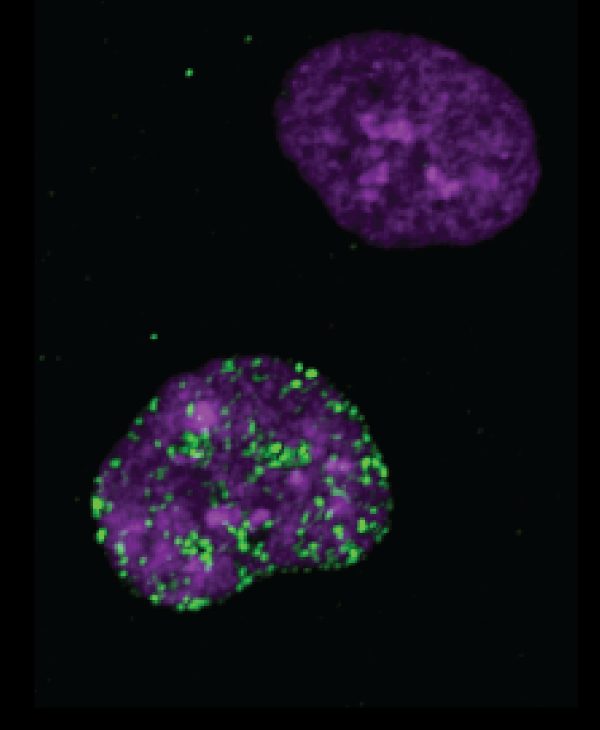Pediatric cancer research between sarcomas and hematology
We are interested in how DNA damage arises in cells, how cells repair that damage, and how cellular metabolism impacts upon genome stability in cancer. Mutations and genome instability arise from errors in DNA repair, while many existing cancer treatments work by overloading cancer cells with cytotoxic DNA damage. Therefore, understanding how cells respond to DNA damage arising from either normal reactive metabolites or exogenous genotoxins (such as environmental carcinogens, radiotherapy or chemotherapy) is vital if we are to understand the origins of cancer and treat it effectively. We use a combination of state-of-the-art CRISPR screening, microscopy, cell biology and biochemistry approaches to dissect the molecular pathways that govern the generation and repair of DNA damage. These approaches are yielding exciting new findings that can help inform better use of existing cancer treatments, as well as highlighting new therapeutic opportunities that span multiple cancer types.
Major leukaemia treatments include a series of nucleoside analogue chemotherapeutics, which work by incorporating into a cell’s DNA and/or RNA. These drugs require metabolism into their active forms for them to be effective. However, despite their widespread use, the precise mechanisms of action of these drugs, and why they are ineffective in some patients, are not fully understood.
Using genome-scale CRISPR screens, our work has highlighted previously-unrecognised determinants of cellular resistance to nucleoside analogue drugs, as well as potential new drug target and opportunities for new combination therapies. We are following up on these discoveries by exploring which of these approaches are the best candidates for transitioning into preclinical models of a range of different types of leukaemias, while also seeking to understand the mechanistic basis of the new drug/drug and gene/drug relationships we have found.
Osteosarcoma is a form of malignant bone tumour that mainly affects children, adolescents and young adults. While surgery supported pre- and post-operative chemotherapy can be beneficial, improvements in 5-year survival rates for osteosarcoma have stagnated, and there is an urgent need to innovative new treatment options.
We are using CRISPR screening and proteomic approaches to explore the molecular and genetic features of a range of available osteosarcoma cell lines to understand the behaviour of the cancers from which they are derived. This includes understanding how they respond to standard of care chemotherapies, identifying the genes upon whose function they depend for proliferation during chemotherapy, and disentangling the complex network of posttranscriptional gene regulation that determines osteosarcoma cells’ behaviour. Through close collaborations within the MMPU Translational RNA Biology with the groups of Matthias Hentze (EMBL) and KiTZ director Andreas Kulozik, as well as our colleagues across KiTZ including Thomas Grünewald, we aim to understand these processes and identify new treatment options that can transform the future of osteosarcoma treatment.
In addition to working in specific cancer types, we are fascinated by the origins of cancer-driving mutations. We are particularly interested in how normal cellular metabolism gives rise to potentially mutagenic agents, and how other aspects of metabolism can mitigate those effects. By complementing these studies with work on the DNA repair processes at work in response to metabolism-derived DNA damage, we seek to understand both how these processes influence the origins of cancer, and their implications for understanding off-target effects of existing cancer treatments.
Carnie, C.J.*#, Acampora, A.C.*, Bader, A.S., Erdenebat, C., Zhao, S., Bitensky, E., van den Heuvel, D., Parnas, A., Gupta, V., D’Alessandro, G., Sczaniecka-Clift, M., Weickert, P., Aygenli, F., Götz, M.J., Cordes, J., Esain-Garcia, I., Melidis, L., Wondergem, A.P., Lam, S., Robles, M.S., Balasubramanian, S., Adar, S., Luijsterburg, M.S., Jackson, S.P.#, Stingele, J.#. (2024). Transcription-coupled repair of DNA-protein crosslinks depends on CSA and CSB. Nature Cell Biologyhttps://doi.org/10.1038/s41556-024-01391-1
Carnie, C.J.*#, Götz, M.*, Palma-Chaundler, C.*, Weickert, P., Wanders, A., Serrano-Benitez, A., Li, H-Y., Gupta, V., Awwad, S.W., Blum, C.J., Sczaniecka-Clift, M., Cordes, J., Zagnoli-Vieira, G., D’Alessandro, G., Richards, S.L., Gueorguieva, N., Lam, S., Beli, P., Stingele, J.#, Jackson, S.P.#. (2024) Decitabine cytotoxicity is promoted by dCMP deaminase DCTD and mitigated by SUMO-dependent E3 ligase TOPORS. The EMBO Journal https://doi.org/10.1038/s44318-024-00108-2
Carnie, C.J.*, Armstrong, L.*, Šebesta, M., Ariza, A., Wang, X., Graham, E., Zhu, K., Ahel, D. (2023). ERCC6L2 mitigates replication stress and promotes centromere stability. Cell Reports 42(4), 112329.
Carnie, C.J.#, Jackson, S.P.# & Stingele, J.# (2024) Transcription-coupled repair of DNA-protein crosslinks. Trends in Cell Biologyhttps://doi.org/10.1016/j.tcb.2024.11.003


